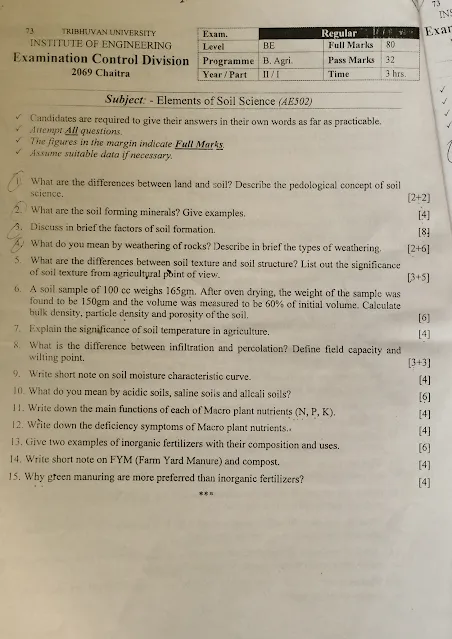 |
| Elements of Soil Science - Past Questions - 2061 Baishakh |
TRIBHUVAN UNIVERSITY
INSTITUTE OF ENGINEERING
Examination Control Division
2061 Baishakh
Exam: Regular/Back
Level: B.E.
Programme: B. Agri.
Year / Part: II / I
Subject: Elements of Soil Science
Full Marks: 80
Pass Marks: 32
Time: 3 hrs.
Candidates are required to give their answers in their own words as far as practicable. Attempt any five questions. The figures in the margin indicate Full Marks. Assume suitable data if necessary.
a) Describe the physical properties of colloids. How do soil colloids influence the availability of nutrients for plant use? [8]
b) What is meant by cation and anion exchange capacity? Describe the significance of cation exchange capacity in agricultural soils. [8]a) Describe the causes and consequences of alkalinity and salinity of soils. What are the options to correct soil salinity? [8]
b) Explain the role of primary soil nutrients in crop production. Describe the deficiency symptoms of nitrogen in plants. [8]a) What is soil aggregation? Explain the stages and processes of the formation of water-stable soil aggregates. [8]
b) Why is soil texture considered a fundamental soil property? Explain the purpose of determining soil texture. [8]a) Explain the pattern of extraction of soil moisture by the root system of crop plants. Describe the working principle of a soil moisture meter. [8]
b) What are the causes of poor soil aeration? Explain the ways and means of managing aeration in soils. [8]a) What is the difference between regolith and soil? Explain the process of soil formation. [8]
b) Explain the procedure for determining soil texture by the hydrometer method. [8]Write short notes on any four: [4 × 4]
a) Nitrification and Denitrification
b) Green Manuring
c) Secondary Plant Nutrients
d) Soil Profile
e) Infiltration Rate



